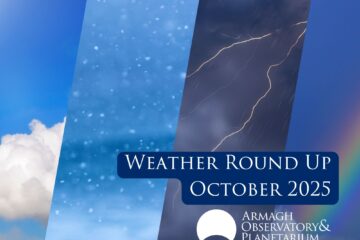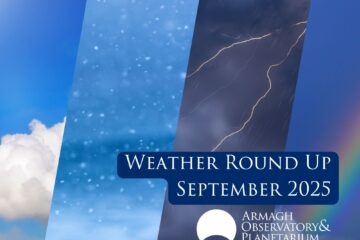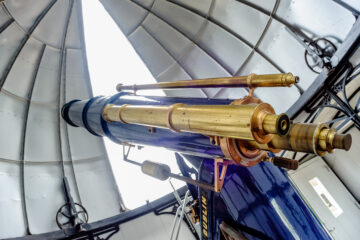Michael Burton, Director of the Armagh Observatory and Planaterium
Monday January 21, 2019 – the last chance to watch a total eclipse of the Moon from Armagh for over a decade. Should we hold a special viewing session to give people the chance of seeing this celestial wonder?! Easy question, not such an easy answer when the eclipse starts at 4:30am. Would anyone really get out of bed and come to the Observatory at such an hour, in the depths of winter?!
A question Armagh astronomer Tolis Christou and I had wrestled with since the great eclipse of July 27, 2018. Then we organised a special session using Armagh’s famous Grubb 10-inch. That one was mid-summer, and the eclipse was at sunset, a very comfortable time for viewing. Quite pleasant to stroll around outside, even if the weather didn’t cooperate.

But winter mornings are a very different matter, would anyone actually come?! So it was only two weeks beforehand that we finally decided to hold an event and find out. The dull, blood-red Moon seen during a total lunar eclipse really is a remarkable celestial sight. We just had to give people the chance to experience it, especially given that it would be many years before they could hope to do so again in Armagh.
A chance to connect with nature and the celestial clockwork of the cosmos, the kind of experience that is increasingly hard to find in modern, urbanised society. And a chance to see the Moon through the heritage Grubb telescope, used by Armagh’s 4th Director, John Dreyer, to compile the famous New General Catalogue (the NGC) in 1888. A catalogue still used by astronomers the world over to find their favourite objects to study in the sky.
We did have one ace up our sleeve. We now have online ticketing for booking Planetarium shows. We could use this tool to find out quickly if any one would be interested, and so cancel if none were. Conversely, we could restrict numbers to a manageable size if it so happened that the event would prove to be popular.
So Planetarium manager Sinead Mackle set up an online booking form and sent out a Facebook post. And lo and behold, people started booking straight away! We quickly reached capacity. So we knew we had an event, we now had to make it work! Ireland is not, alas, blessed with many clear nights, so we needed back-up plans. Our event of last July was completely clouded out, but we a had host of other activities on stand-by to turn to. We needed to do similar.
It is also possible to view the eclipse live, elsewhere on the globe, as many web cameras are set up by professionals and enthusiasts alike. So, while we gave our talks, a display screen also showed the eclipse in progress, and up close, at some other locale. The ethereal nature of the blood red Moon during eclipse was readily apparent to us, even if the camera being used was a few thousand kilometres away. We knew it was happening outside too, if only the clouds weren’t there!

Still, giving a talk at 4am in the morning is not normal, however enthusiastic you might be! Just like in the summer, our backup plan also had to swing into action. The Moon was just visible through the clouds when we started, already in the partial phase of the eclipse. The bite out of the Moon by the Earth’s shadow could clearly be seen. A giant halo could be seen around the Moon, produced by the scattering of moonlight by ice crystals in high altitude cirrus clouds. A circle 22 degrees in diameter centred on the Moon. It was a winter night after all, so it was cold. So while everyone was assembling, we conducted a viewing. Binoculars outside on the Human Orrery, telescope inside the Robinson Memorial Dome with the Grubb. Not that the Moon was actually easy to see through the telescope, but it was there with a little imagination. And you were getting to use the historic Grubb!
Totality started at 4:41am. By then the Moon was barely visible at all. It really did take some imagination to perceive it through the clouds! So we all retreated inside. Tolis and I talked about eclipses and the Grubb telescope. While we watched the eclipse over North America on the screens. There it was a much more civilised hour, before midnight. A few minutes before totality ended (which was 5:44 am), Armagh PhD student Boris Nedelchev informed us there was a slight lessening of the clouds. Enough at least for the Moon to be perceived again. So we rushed out, and most got to see a ghostly shape through the Grubb before opaqueness returned more. Though it was too hazy to discern any red colour.


Following the eclipse we then simulated it using a planetarium programme on the computer. Here we could see the event as it should have been seen. Zooming into the Moon, and out again to see the whole sky. Also an opportunity to talk about other objects in the night sky, especially the planets. None would have been visible during the eclipse, but both Venus and Jupiter rose almost together as it ended. So, while this could not be seen outside either, on the screen it could. We zoomed in to examine the planets in detail, and look at their moons, and discuss where life might be found in our Solar System?!
Our “viewing” ended at 6:30am, but by chance an Iridium satellite flare was due in the southern sky just afterwards. This is a brief, bright “star” that rapidly moves across the sky, caused by reflection of sunlight off a communication satellite in low Earth orbit. So, true believers that our visitors all were, we all assembled on the Human Orrery once last time to hope that the flare would be seen through the clouds. Alas, it couldn’t, the clouds had got even thicker. But our visitors seemed undaunted. They had experienced an eclipse, even if not actually in their sky. And they had (just about) seen the Moon through the famous Grubb telescope. We all hope for better conditions in 10 years time!



1 Comment
Trying to find the Moon – the struggles of an eclipse chaser - Astronomy Hobby ZoneAstronomy Hobby Zone · February 15, 2019 at 10:51
[…] Supply hyperlink […]